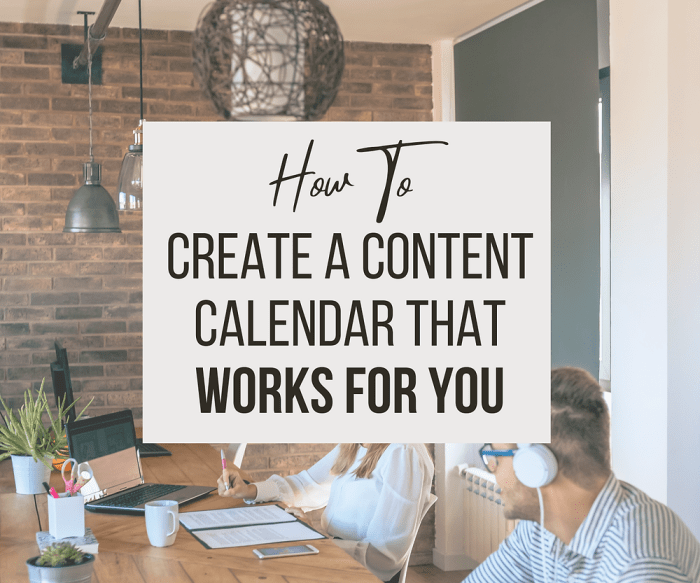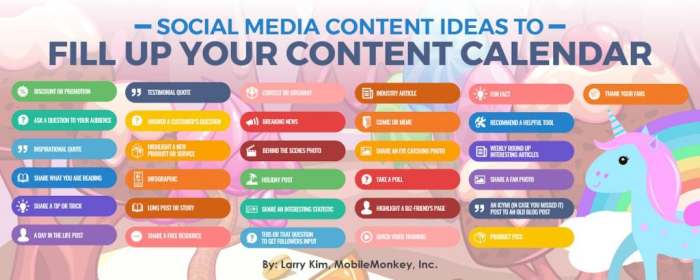Building Social Media Content Calendars sets the stage for strategic planning and consistent engagement, offering a roadmap to success in the digital realm. Dive into the world of content creation and organization with this essential guide.
Importance of Social Media Content Calendars
In the fast-paced world of social media, having a well-planned content calendar is essential for success. Here are some reasons why content calendars are crucial:
Consistent Posting Schedule
- Content calendars help in maintaining a consistent posting schedule, ensuring that your audience knows when to expect new content from you.
- Consistency is key in building brand awareness and keeping your followers engaged.
- By planning ahead and scheduling posts, you can avoid gaps in your content strategy and stay top-of-mind with your audience.
Organizing and Strategizing Content
- Content calendars allow you to organize and strategize your social media content effectively.
- You can plan out themes, campaigns, and promotions in advance, ensuring that your content aligns with your overall marketing goals.
- With a content calendar, you can easily track the performance of your posts, identify trends, and make adjustments to optimize your social media strategy.
Creating a Social Media Content Calendar

Creating a social media content calendar from scratch can seem overwhelming, but breaking it down into manageable steps can make the process much easier.
Setting Up a Content Calendar
- Start by outlining your goals and objectives for your social media content.
- Identify your target audience and understand their preferences and behaviors.
- Decide on the frequency of your posts and the platforms you will be using.
- Brainstorm content ideas and themes that align with your brand and resonate with your audience.
- Choose a calendar format that works best for you, whether it’s a digital tool or a simple spreadsheet.
- Map out your content schedule, including key dates, events, and holidays that are relevant to your audience.
Selecting the Right Tools
- Consider using social media management tools like Hootsuite, Buffer, or Sprout Social to schedule and manage your content.
- Utilize content creation tools like Canva or Adobe Spark for designing visually appealing posts.
- Explore analytics tools to track the performance of your content and make data-driven decisions.
- Collaborate with team members by using project management tools like Trello or Asana.
Importance of Key Dates and Events, Building Social Media Content Calendars
Including key dates, events, and holidays in your content calendar is crucial for staying relevant and engaging with your audience. By planning ahead and aligning your content with important dates, you can create timely and impactful posts that resonate with your followers. It also helps in maintaining a consistent posting schedule and ensures that you don’t miss out on any opportunities to connect with your audience.
Content Types and Themes: Building Social Media Content Calendars
When it comes to social media content, variety is key. Different types of content can help keep your audience engaged and interested. From informative posts to entertaining videos, each type serves a purpose in your content calendar.
Identifying Content Types
- Images: Eye-catching visuals can help grab the attention of your audience.
- Videos: Engaging video content can be highly shareable and increase reach.
- Infographics: Informative graphics can help simplify complex information for your audience.
- Blog Posts: Longer-form content can provide in-depth information on a specific topic.
- Polls and Surveys: Interactive content can encourage audience participation and feedback.
Choosing Themes and Topics
- Understand Your Audience: Consider what topics your audience is interested in and tailor your content to meet their needs.
- Stay Relevant: Keep up with current trends and events to ensure your content remains timely and engaging.
- Align with Brand Values: Choose themes and topics that align with your brand’s values and messaging to maintain consistency.
- Diversify Content: Mix up your content themes to appeal to different interests within your audience.
Balancing Promotional and Engaging Content
Maintaining a balance between promotional and engaging content is crucial for keeping your audience interested. While promotional content can help drive sales and conversions, too much of it can turn off your audience. By incorporating engaging content such as behind-the-scenes looks, user-generated content, and interactive posts, you can keep your audience interested and foster a sense of community.
Scheduling and Frequency

When it comes to social media, timing is everything! Scheduling your posts at the right time and frequency can significantly impact your engagement and reach. Let’s dive into some best practices for scheduling and frequency across different platforms.
Best Practices for Scheduling Posts
- Utilize social media management tools like Hootsuite or Buffer to schedule posts in advance.
- Consider the time zones of your target audience and schedule posts accordingly for maximum visibility.
- Experiment with different posting times to see when your audience is most active and adjust your schedule accordingly.
- Monitor trending topics and current events to ensure your content is timely and relevant.
Determining Optimal Posting Frequency
- Understand the algorithm of each platform to determine how often you should post without overwhelming your audience.
- Take into account the nature of your content – some platforms like Twitter require more frequent updates compared to Facebook or LinkedIn.
- Analyze engagement metrics such as likes, comments, shares, and click-through rates to gauge the impact of your current posting frequency.
Importance of Analyzing Engagement Metrics
- Regularly review your social media analytics to identify patterns in engagement and adjust your posting schedule accordingly.
- Track the performance of different types of content to understand what resonates best with your audience.
- Use A/B testing to compare the effectiveness of different posting schedules and refine your strategy for optimal results.
